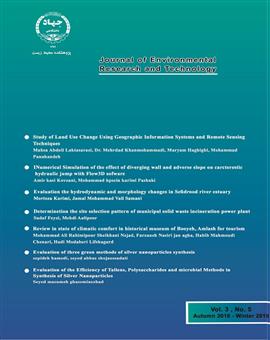Evaluation and comparison of some green methods for synthesis of silver nanoparticles
Subject Areas : Water and wastewater technologysepide hamedi 1 , seyed abbas shojaossadati 2
1 -
2 - Tarbiat Modares University
Keywords: Green synthesis methods silver nanoparticlesnitrate reductase enzyme,
Abstract :
Nowadays, there is an increasing need to develop high-yield, low cost, nontoxic, and eco-friendly procedures for synthesis of metallic nanoparticles. Therefore, the green synthesis methods become customary for synthesis of nanoparticles. Among metallic nanoparticles, nanosilver has developed because of its therapeutic properties. So in this paper, polysaccharide, tollens and biological green methods were investigated. In polysaccharide and tollens methods, starch and β-D glucose were used as a satabilizer and reducer respectively. In biological method biomass and cell filtrate of the Fusarium oxysporum fungus were used for the synthesis of nanoparticles. SEM images and UV-visible absorbtion spectra of these procedures showed that the polysaccharide method produced smaller silver nanoparticles wih high productivity. The changes of NADH-dependant nitrate reductase enzyme activity was evaluated in growh duration by colorometric Harely method due to importance of this enzyme in extracellular synthesis of silver nanoparticles. Results showed that the changes of dry cell mass impact on the enzyme activity.
1. Prasad, K., Anal, K. J., (2010). Biosynthesis of CdS nanoparticles: An improved green and rapid procedure, Journal of Colloid and Interface Science. 342: 68-72.
2. Gajbhiye, M., Kesharwani, J., Ingle, A., Gade, A., Rai, M., (2009). Fungus-mediated synthesis of silver nanoparticles and their activity against pathogenic fungi in combination with fluconazole. nanomedicine. 5: 382-386.
3. Khosravi, A., Shojaosadati, S. A., (2009). Evaluation of silver nanoparticles produced by fungus Fusarium oxysporum. International Journal of Nanotechnology.6: 973-983.
4. Shirinyan, A., M. Wautelet., (2006). On phase change in nanosystems. Materials science and engineering. 26: 735-738.
5. Saifudin, N., Wong, C.W., Nur yasumira, A. A., (2009). Rapid Biosynthesis of Silver Nanoparticles Using Culture Supernatant of Bacteria with Microwave Irradiation, E-Journal of Chemistry. 6: 61-70.
6. Ahmad, A., Mukherjee, P., Senapati, S., (2003). Extracellular biosynthesis of silver nanoparticles using the fungus Fusarium oxysporum. Clloids and surfaces. 28: 313-318.

